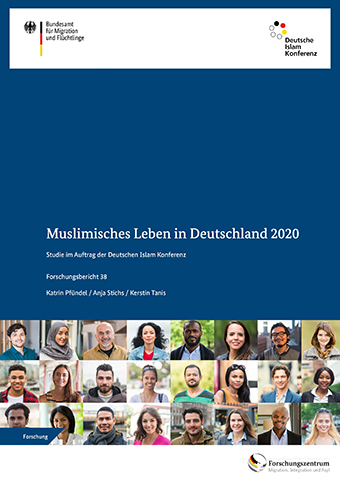Muslim life in Germany 2020 ,
 Source: BAMF
Source: BAMF
The research report on the study entitled "Muslim life in Germany 2020 (MLD 2020)" contains up-to-date knowledge about the Muslim population group living in Germany. A total of around 5,200 people were surveyed for this study between July 2019 and March 2020.
The study "Muslim life in Germany 2020" was carried out on behalf of the German Islam Conference (DIK). First of all, a new extrapolation of the number of Muslims living in Germany was conducted, as well as an analysis of the social structure. The study then goes on to provide reliable information about Muslims' everyday religious practice and on various aspects of their integration.
Comparisons were made with other social groups in order to make it possible to classify the results. This allows differences and similarities to be shown between Muslims and members of another religion from the same countries of origin, as well as people with no migration background.
Core results of the MLD study 2020
Results of the extrapolation
Between 5.3 and 5.6 million Muslims with a migration background from a predominantly Muslim country of origin live in Germany. This means that the share of Muslims with a migration background among the overall population in 2019 was between 6.4 and 6.7 percent.
The Muslim population in Germany has become more diverse in the years since 2008, albeit individuals from Turkey continue to form the largest group of origin among Muslims.
A significant majority of Muslim men and women are religious
82 percent of the surveyed Muslims state that they are very religious or somewhat religious. They are thus significantly more religious than Christian individuals with no migration background, but not more so than individuals with a migration background who are Christian or belong to another religion.
70 percent of Muslim women and girls do not wear headscarves
Whether women wear headscarves depends very much on their age. It is fewer than one percent among girls of kindergarten or primary school age (aged up to 10). The share increases with the onset of puberty. 62 percent of women over the age of 65 wear headscarves.
Muslim women and men frequently assess their German language skills as good or very good
Most Muslims assess their German language skills as good or very good (79 percent). Almost all Muslims who were born in Germany state that they have a very good knowledge of German (93 percent).
A backlog in demand can be observed in school education and vocational training
The educational level of Muslims aged 16 and older is often lower than that of people with no migration background. Particularly the proportion of people without a school-leaving certificate is higher. It can however be observed that there has been an upward trend in the level of education among Muslim women and men who were born in Germany.
No social isolation trends discernible
65 percent of Muslims say that they frequently have contact with people in their circle of friends who do not have a migration background. In addition, there are contacts with persons who have no migration background in the family, in the neighbourhood, or at work. Muslims with fewer social contacts show a strong desire for more frequent contact with persons who have no migration background, meaning that a high degree of openness is evident overall.
The influence of religion on integration is often overestimated
The results of the analyses show that, with regard to the integration indicators considered, Muslim women and men hardly differ from persons belonging to another religion who also have a migration background from one of the considered predominantly Muslim countries.
The research report was prepared by: Katrin Pfündel, Dr. Anja Stichs and Dr. Kerstin Tanis
The full research report is only available in German.

